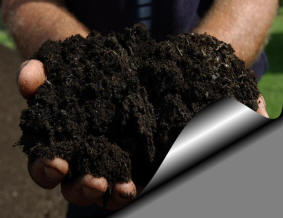

The High Country Xeriscape Council of Arizona is a non-profit 501 C-3 corporation dedicated to educating our communities about water-wise gardening. For additional information write:
HCXCA
4397 E AZ Highway 260
Payson, AZ 85541
Once the bin is constructed, stockpile dry organic material and follow these ten steps:
Shred or chop all material into as small as possible pieces to expose the most surface area for the microbes to work on.
Loosen 2" of soil where the bin will stand. Add a 6 - 12 inch layer of finger-sized branches to allow air to enter from below.
Provide a mixture of about 4-parts brown or woody material (carbon-rich) to one part green or moist (nitrogen-rich). Up to a 50/50 mix can be used.
Layer green and brown materials alternately, not more than 4 inches thick. Occasionally sprinkle in soil and/or manure. If using food, be sure to cover it with plenty of carbon material.
Insure it is very wet throughout the pile. During periods of heavy rain, cover with a tarp or scrap of carpet.
Once your container is full, top-off the pile with 2 feet of manure or carbon material.
As decomposition takes place, the pile will begin to heat up. Interior heat can reach 165° and can be checked by inserting a metal rod or your hand into the pile.
Before the pile cools down to outside temperature, reactivate it by turning the material into a second bin or use a pitchfork to thoroughly mix the pile. Water and/or green material can be added at this time. This will ensure compost in 2 or 3-months. You can turn your pile less often but it will take longer for finished compost.
Repeat these steps as needed until the mixture is soft, dark, and crumbly.
To use the finished compost, sift on a 1/2 inch screen to remove large pieces. Return these to the bin for further breakdown.
ref: Tucson Organic Gardeners
Compost Makes Soil Healthier - Compost returns organic matter to the soil in a usable form. Organic matter in the soil improves plant growth by: stimulating the growth of beneficial microorganisms, loosening heavy clay soils to allow better root penetration; improving the capacity to hold water and nutrients particularly in sandy soils; and adding essential nutrients to any soil. Improving your soil is the first step toward improving plant health.
Composting and the Environment
- Yard trimmings and kitchen scraps use up valuable space in landfills-space that is running out fast! These materials make up 20 to 30 percent of all household wastes. The use of compost can also reduce the use of pesticides and chemical fertilizers in your yard.Compost Materials - leaves, grass clippings, weeds, thatch, and the remains of garden plants, ground brush, wood ash, and kitchen scraps such as fruit and vegetable peelings, egg shells, and coffee. Grass clippings and leaves treated with pesticides should not be used as a mulch immediately after application and mowing, but should be composted.
Composting Essentials - Bacteria, the most numerous and effective microbes, are the first to break down plant tissue. Fungi and protozoans soon join the bacteria. Springtails, mites, and other small insects, as well as earthworms, also play a role in decomposition once the compost has cooled. ![]()
Everything organic has a given ratio of carbon to nitrogen (C:N) in its tissues. A C:N ratio of 30:1 is ideal for the activity of compost microbes. Composts often are deficient in nitrogen when wood wastes are added to the mixture. This can be corrected by adding 1 pound of urea per cubic yard of compost mixture.
Volume - A large compost pile insulates itself and holds the heat of microbial activity. Its center will be warmer than its edges. Piles smaller than three feet cubed (27 cu. ft.; 3-4 ft tall) have trouble holding this heat in the winter, while piles larger than five feet cubed (125 cu. ft.; 5-6 ft tall) do not allow enough air to reach the microbes at the center. These proportions are of importance if your goal is fast, high temperature composting. Large piles are useful for composting diseased plants or trees as the high temperatures will kill pathogens and insects.
Moisture and Aeration - All life on Earth, including compost microbes, needs a certain amount of water and air to moisture balance. Generally, the moisture content of the compost should be 50 to 6 percent on a total weight basis. Never cover compost piles with plastic because this does not permit introduction of air.
The larger the pile, the higher the temperature and the faster the composting proceeds, but only up to a certain point. At temperatures higher than 160 degrees F, composting slows down and charring or burning begins. This can become a problem in dry composts, particularly in the summer.
Preparation and Use of Compost - Remove grass and sod cover from the area where you construct your compost pile to allow direct contact of the materials with soil microorganisms. The following "recipe" for constructing your compost heap is recommended for best results: 
1st layer: 3-4" of chopped brush or other coarse material on top of the soil surface. This material allows air circulation around the base of the heap.
2nd layer: 6-8" of mixed scraps, leaves, grass clippings, etc. Materials should be "sponge damp."
3rd layer: 1" of soil serves as an inoculant by adding microorganisms to the heap.
4th layer (optional): 2-3" of manure to provide the nitrogen needed by microorganisms. Sprinkle lime, wood ash, and/or rock phosphate over the layer of manure to reduce the heap's acidity. Add water if the manure is dry. Add one pound of urea fertilizer or 10 pounds of composted poultry manure per yard of leaves or ground brush if organic sources of nitrogen are not available. Soak these high carbon materials with water before composting. Manure generally should not be used in cities to reduce the potential for fly problems.
5th layer: Repeat steps 1-4 until the bin is full. Scoop out a "basin" at the top to catch rainwater under summer conditions.
After 3-4 weeks, fork the materials into a new pile, turning the outside of the old heap into the center of the new pile. Add water if necessary You can make compost even faster by turning the pile more often.
Compost is ready to use when it is dark brown, crumbly, and earthy-smelling. Let it stabilize for a few extra days and screen it through a 1/2" screen if you want the finest product for germination of seedlings. Compost generally should be at least 4 - 6 months old for use with plant seedlings. Apply a 1 - 2" layer of compost, and work it in well where you want to grow root crops.
Common Composting Problems -
Symptoms | Problem | Solution |
Pile has a bad odor | Not enough air or Too Wet | Turn it; add dry material if pile is wet |
Center of pile is dry | Not enough water. | Moisten and turn pile |
Pile is damp and warm only in middle | Too small | Collect more material mix the ingredients into a new pile and turn. |
Heap is damp and sweet-smelling
| Lack of nitrogen. | Mix in a nitrogen source like fresh grass clippings, manure, composted poultry manure, blood meal, or urea fertilizer |
For more reading, click on these links:
http://modularhomeowners.com/how-to-compost-at-home/
http://www.homeadvisor.com/article.show.Home-Gardening-Tips-From-Composting-To-Herb-Gardens.17373.html
![]()
copyright 2003-2015© HCXCA
